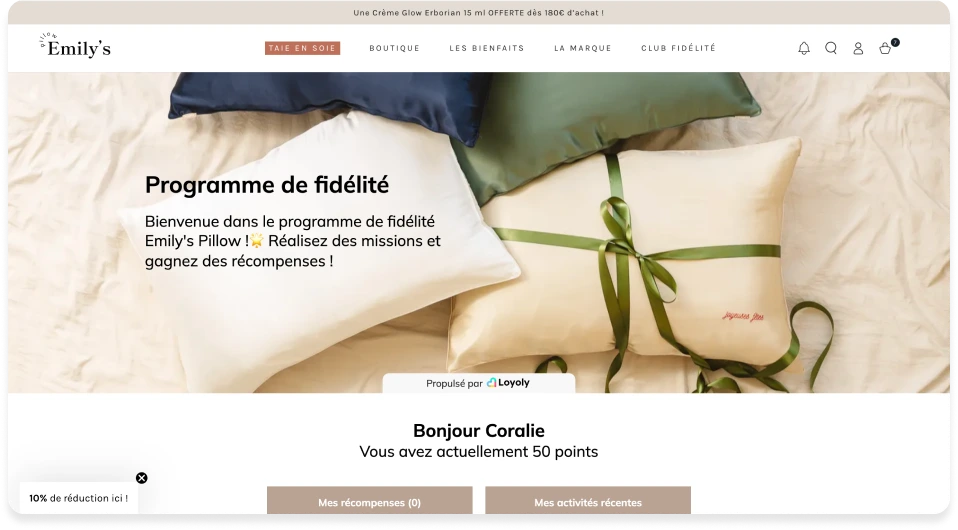

Founded with the aim of democratising the benefits of mulberry silk, Emily's Pillow offers high-end sleep accessories, combining comfort, elegance and respect for tradition.
It all started with a simple observation: silk is hypoallergenic and less absorbent than cotton. It is therefore a real ally for hydrated skin and soft hair. By selecting quality suppliers and Oeko-Tex certified materials, the brand is committed to offering sustainable and healthy products.
From 100% silk pillowcases to scrunchies, sleep masks and sheets, every Emily's Pillow creation is designed to improve sleep while taking care of us.

Optimizing customer acquisition cost
Increasing the number of repeat purchases
Boosting purchase frequency and AOV
Before collaborating with Loyoly, Emily's Pillow faced three major challenges.
First, the brand wanted to optimise its customer acquisition cost (CAC) by relying more on its existing customer base, rather than solely on paid channels.
Then, it sought to increase the customer lifetime value (LTV) by boosting both the purchase frequency and the average order value.
Despite a committed community, getting customers to make repeat purchases remained a challenge.
The brand therefore needed a solution capable of boosting loyalty and engagement.
Monthly ROI of 48
x3 LTV
+21% AOV
For more than a year, Loyoly has been supporting Emily's Pillow in the management of its loyalty and referral program. A comprehensive system that has borne fruit and continues to grow.
Emily's Pillow has adopted a simple and attractive loyalty program based on a points system.
Customers earn 10 points for every euro spent.
These can then be exchanged for vouchers worth between €5 and €20.

Emily's Pillow has supplemented its transactional approach to loyalty with a relational dimension, encouraging its customers to interact with the brand beyond their purchases.
By offering missions such as subscribing to the newsletter, following the brand on Instagram or entering their birthday, it has strengthened the commitment of its community while increasing the number of contact points throughout the customer journey.

To reward its most committed customers, Emily's Pillow has set up a loyalty program structured in three VIP levels: Bronze, Silver and Gold, determined according to the total amount spent.
The higher a customer progresses through the tiers, the more exclusive benefits they gain access to.
At the first levels, the rewards remain mainly transactional, with discounts, bonus points and special offers.
By reaching the higher statuses, members benefit from experiential advantages such as access to preview collections, invitations to private events and priority customer service.
This system has strengthened brand loyalty, while encouraging an increase in the average order value and long-term customer retention.

Emily's Pillow has also launched a simple and attractive referral program to turn its customers into ambassadors.
For each validated recommendation, the referrer and the referee each receive €10, a win-win system that encourages sharing while boosting acquisition.
In one year, this approach has attracted nearly 100 new customers, while building on trust and natural recommendation.
Thanks to this lever, the brand has strengthened its community and optimised its acquisition without relying solely on paid channels.

In just one year, Emily's Pillow's loyalty and referral program has had a significant impact on the growth of the brand.
Thanks to these initiatives, an additional €67,000 in revenue has been generated, with an impressive monthly ROI of 48.
Customers enrolled in the program now play a key role in the brand's performance, accounting for 26% of total sales.
But beyond the sales volume, it is the behaviour of loyal customers that has really changed.
They place on average twice as many orders as those who are not registered.
The average order value follows the same trend, showing an increase of 21% compared to users without a customer account.
Ultimately, the LTV of customers engaged in the program is three times higher than others.
The use of rewards also follows an upward curve: from the second purchase, 8% of baskets contain rewards, a figure that rises to 26% by the fourth purchase, proof of their role in activation and loyalty.
In terms of engagement, data collection has also been optimised with 850 opt-ins synchronised directly in Klaviyo.
We are delighted to be working with Loyoly! Our customers love the points system; it's simple and motivating for them. We quickly realised that the more ‘gaming’ mechanics, such as earning points for a story, a post, etc., didn't work too well with our community. Fortunately, Loyoly offers a lot of flexibility, which has allowed us to adapt the program by focusing on what our customers really like. The result: they are more engaged, and we even see a slightly higher average order value among Loyoly customers!
